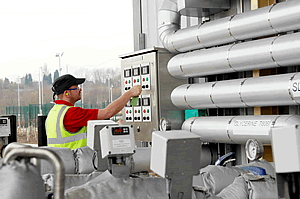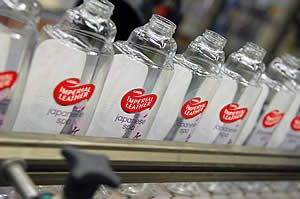Application Stories
Leading personal wash company, PZ Cussons, has invested in a new high-speed liquids manufacturing facility, significantly increasing capacity as well as benefiting from a more efficient process.
 Its old site, which had grown organically over a long period of time, was unable to deliver the production volumes to meet the demands of the business. It also experienced too much operator intervention at virtually all stages of manufacturing, which often introduced unwanted levels of product variability. The company knew that significant cost savings could be made by its production operations and recognised that only a modern process plant would help it to realise these.
Its old site, which had grown organically over a long period of time, was unable to deliver the production volumes to meet the demands of the business. It also experienced too much operator intervention at virtually all stages of manufacturing, which often introduced unwanted levels of product variability. The company knew that significant cost savings could be made by its production operations and recognised that only a modern process plant would help it to realise these.
Challenge
As part of a complete overhaul and modernisation of its UK supply chain, PZ Cussons decided to take advantage of the control and visibility capabilities offered by a modern process-capable automation infrastructure. While establishing the justification for a new UK manufacturing facility, the company realised that much of its existing process equipment at its old site was not up to the demands of a modern manufacturing environment. This is one of the reasons why it chose to employ the very latest technology available from Rockwell Automation and Recognized Systems Integrator partner.
The solution was based on the ISA S-88 standard, utilising networked instrumentation and routing valves and utilised Rockwell Automations Integrated Architecture™ and Intelligent Motor Control infrastructure. This allowed the use of a common software environment and scalable solution which made installation and cross-line migration incredibly straightforward.
 Starting with a ‘clean sheet of paper’, PZ Cussons recognised many areas where savings could be made and unnecessary costs removed. It also wanted to adopt leaner manufacturing procedures making further savings in stock holding and deliveries. The primary challenge was to obtain visibility of all steps of the process and to keep all parameters within operational tolerances. This required extremely accurate batching, mixing and metering systems, which could not only communicate with each other, but also with the master control system within the offices and external suppliers via a secure extranet.
Starting with a ‘clean sheet of paper’, PZ Cussons recognised many areas where savings could be made and unnecessary costs removed. It also wanted to adopt leaner manufacturing procedures making further savings in stock holding and deliveries. The primary challenge was to obtain visibility of all steps of the process and to keep all parameters within operational tolerances. This required extremely accurate batching, mixing and metering systems, which could not only communicate with each other, but also with the master control system within the offices and external suppliers via a secure extranet.
Benefits of Continuous Production
An entirely new processing and production operation was developed, controlled by equipment engineered, supplied and improved by services from Rockwell Automation and Recognised System Integrator W H Good Automation. The implementation of the project made full use of the flexibility, the improved process and diagnostic data that the networked devices provide. This has given PZ Cussons a level of process visibility and control far beyond what it had in its older plant.
“Network connection allowed us to develop standardised modules for VSDs (Variable Speed Drives) and DOLs (Direct Online Starters) and use these repeatedly. This speeded the design process significantly and provided PZ Cussons with a system that was both easy to understand and maintain.”
Neil Thompson
Control Systems Engineer
The new approach is helping PZ Cussons to attain many of the savings it envisaged, while also removing many of the process variables which introduced unwanted costs. By measuring and automating virtually every step of the recipe creation, mixing, processing and packaging lines, the total solution supplied by Rockwell Automation and W H Good Automation has had a significant impact. The savings have been such that the company is vindicated in its decision not to move manufacturing to alternative locations outside of the UK.
The flexibility of the Intelligent Motor Control concept allowed the software system to be developed in parallel with the panel construction by W H Good Automation which helped reduce the implementation time.
E3 electronic overloads are also used to control and monitor all fixed-speed motors. DeviceNet connectivity helped significantly reduce wiring time and allowed for monitoring of conditions such as overload, under-load, jam, stall & phase-loss. The DeviceNet-controlled starters can also be accessed seamlessly from any Ethernet connection.
Contract to replace six Siemens S5 PLC’s with six new Siemens S7 PLC’s and replace four HMI’s with four Siemens HMI’s.
Scope of work
- Preparation of 5-off Functional Design Specification
- The design, manufacture, installation and testing of new back plates and remote I/O stations
- Siemens S7 software design and commissioning
- RS View SCADA system modifications and readdressing and installation of a Win CC SCADA system
- Integration of remote 3rd party equipment
- Associated electrical installation work and cabling
- Onsite commissioning and support
Control of the plant
- Level control
- Flow control
- Pressure control
- Duty/standby changeover
- Screen stepping control
- Storm tank filling control
- Ethernet communications over WAN
- Fibre to ethernet communications
- Dual ethernet communications
Plant details
- Variable speed pumps
- Valves and penstocks
- Screens and compactors
- Submerged biological contactors
- Storm tanks
- Final settlement tanks
- Air blowers
- Ventilation systems
- Sump pumps
Special project requirements
The system that these PLC’s run is a 24/7 operation and cannot be stopped. But the customer was able to shutdown and run the plant manually for 12 to 48 hours to allow the PLC to be changed.
This made the change over a critical time, as everything had to work. Removing the old PLC, fitting the new PLC and commissioning the critical plant had to be done with in the shutdown period. Once the plant was running on the new PLC the non-critical commissioning and fine-tuning could be done.
The plant could then be run locally on the new LOI for a short period whilst the communications to the SCADA was tested and commissioned.
Summary
All the PLC’s were changed successfully whilst the plant was in operation with minimal disruption. The longest outage period was 36hrs, with four of the PLC replaced within 12hrs shutdown periods. All the plant can now be viewed and operated via the SCADA.
Value: £265k
The automation division were awarded the contract to design and manufacture three panels for a Sunflower Oil Extraction Plant in Russia.
Scope of work
- The design, manufacture and testing of the three panels
- Siemens S7 software design & commissioning
- Making data available & communications to a SCADA system
- Supply of all instrumentation, including configuration of all control loops
- Onsite support
Control of the plant
- Level, pressure & temperature control
- Pressure control
- Temperature control
- Flow control
- Weight & loss in weight feeder control
- Mixing and blending control
- Current Control
- Inverter & Soft start Drives
Plant details
- Cracking & Flaking Rolls
- Belt & Screw Conveyors
- Elevators
- Pumps
- Filters
- Heat Exchangers
- Presses
- Conditioners/Dryers
- Mixing Vessels
- Vibrator Feeders
Special project requirements
All panels had to be built to a Russian specification with all legend and warning labels in Russian. The panels were built to a high specification with a busbar rating of 3200A in one of the panels. The panels control motors from 2.2KW to 500KW via DOL, S/D, soft start and inverter drives. The Siemens S7 PLC system was programmed to control the plant including many types of control including loss in weight and PID.
Summary
All the panels were tested at our works with the customer before shipping. All the PLC and simulated SCADA communications were tested as testing specification.
Value: £142k
The automation division were awarded the contract to design and manufacture two “fluidised bed combustion” systems along with the associated handling plants and power generation plants.
Scope of work
- Writing of the functional design specification
- The design, manufacture, installation and testing of the PLC, I/O panels & control room desks
- Allen Bradley PLC software design and commissioning
- Wonderware SCADA system design and commissioning
- Supply of all instrumentation, including configuration of all control loops
- Associated electrical installation work and cabling
- Onsite commissioning and support
Control of the plant
- Level, pressure and temperature control
- Volume control
- Weight and loss in weight feeder control
- Mixing and blending control
- Moisture control
- Boiler level control
- Soot blower control
- Reverse jet filter control
- Exhaust gas correction control
- Power generation monitoring
Plant details
- Grinders and crushers
- Pumps and dosing pumps
- Screening
- Belt, screw and elevator conveyors
- Compressors and blowers
- Boilers economisers and soot blowers
- Bag filters and gas analysis
- Condensers and deaerators
- Turbines and generators
- Water treatment
Special project requirements
The requirement was for that both plants were simultaneously commissioned and handed over to the client, nine months from the project start date. Careful planning and control of the project was a necessity to ensure that our resources were best utilised to meet the project milestones as dictated by the ‘Microsoft Project’ plan.
Good customer communication was essential, and an excellent working relationship was critical to enable the detailed functional design specifications to be completed and approved in a short time frame.
The suite of panels were designed, manufactured, works tested and delivered ahead of schedule. The PLC and SCADA software was fully tested prior to arrival at site ensuring that the commissioning cycle was performed efficiently and in minimal time.
Summary
Both projects were complete on time and within budget, with the customer satisfied with the control and manufacture of the system.
Value: £380k
![]()


